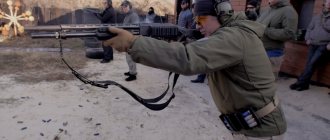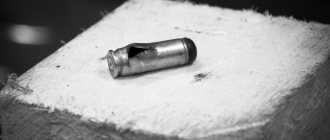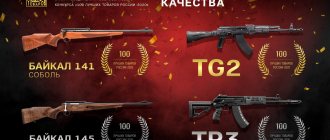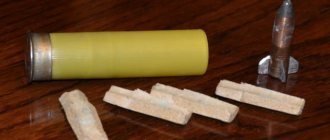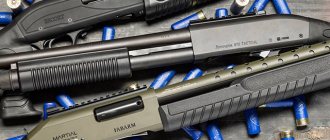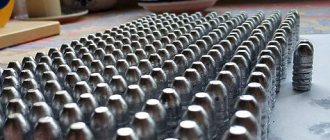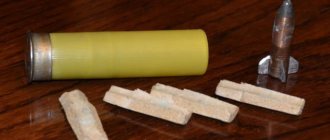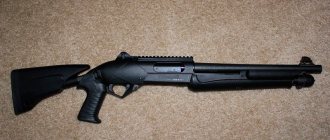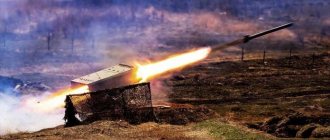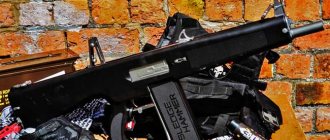For people of military specialty, whose professional activities involve the frequent use of firearms, situations are well known when success is brought by one powerful volley. The use of large-caliber weapons for this purpose, firing bullets or shot charges, allows you to quickly achieve a certain tactical advantage. A shotgun smoothbore weapon can easily be included in this category. The name of the barrel alone speaks volumes about its mode of action.
Shot shooting
This type of firearm is well known to hunters who hunt game birds. In this case, the main damaging element is shot, which allows you to achieve a large damage area. Despite the fact that the use of smooth-bore hunting rifles for military purposes turned out to be ineffective, the military was able to properly evaluate the effect when shooting shotguns. The result of the transformation of smooth-bore guns into powerful military weapons was combat shotguns, which are used today by the army, special forces and law enforcement forces.
KEL-TEC KSG
KSG smoothbore weapons are manufactured by Kel-Tec from America. This is a popular firearm among professionals and amateurs. The gun has a non-standard appearance, slightly similar to the design of the South African Neostead shotgun. The model has excellent characteristics, thanks to which this model will become a treasure in the arsenal of every connoisseur of high-quality shooting.
The weapon was first shown at ShotShow 2011, and a year later it went on sale to amateurs. The weapon is reloaded manually using pump-action reloading. The shotguns are compact, they have an original high-capacity double-tube magazine, and they are comfortable to aim with. The firearm is used by the army and security forces; the gun is valued by private collectors.
Popular models of our time
Most models of pump-action shotguns are developed for the needs of the civilian weapons market. However, as they go on sale, as often happens, such weapons quickly find their niche in paramilitary structures. Currently, almost any automatic hunting shotgun has a military or police equivalent. The commercial market is driving progress in this regard as well. The creation and development of new types of smoothbore shotguns is proceeding at an accelerated pace. These weapons are produced all over the world. Among the popular models you can find American, Italian, Belgian and Turkish models of smoothbore shotguns, each of which was created for a specific category of consumers.
SRM ARMS MODEL 1216
Tactical model created by American manufacturers. The model has 12 gauge and a four-chamber magazine. Production started in 2008. During its not yet very long history, the shotgun has become famous. There are three types of weapons. They differ in size, magazine volume, and barrel length.
The sample differs from other models of a similar type in its non-standard magazine and bolt. Due to its small size and plastic body, the weight of the weapon is reduced. Like the M16 rifle, the body of the firearm is made up of two parts, they are fastened with cross pins.
Technical side of the issue
A shotgun is a smooth-bore firearm, derived from a hunting rifle, which gunsmiths have converted in accordance with the conditions of combat use. A pistol grip was added to the butt used for shooting from the shoulder, allowing firing from the belt line or offhand. Combat shotguns have also retained hunting calibers, which vary in the range of 5.5 mm - 5 cm.
Weapons of this type are divided into the following types:
- by trunk type;
- by the number of trunks;
- according to the recharging mechanism.
Depending on the type of barrel, guns can be smooth-bore or combined, capable of firing both bullets and shot charges. Depending on the number of barrels, shotguns can be single-barrel, double-barrel or multi-barrel. This type of weapon also differs in its loading mechanisms. There are models with a pump-action reloading mechanism and with a lever-action reloading device. The model range includes self-loading and automatic shotguns.
Double-barreled shotgun
The double-barreled shotgun is the most popular and widespread type. Most amateur hunters prefer to use this particular weapon design in their craft. Typically, a hunting shotgun is a typical double-barreled hunting shotgun that is loaded by breaking. The main effect is achieved through a double shot, when a double charge of shot is fired from two barrels with a difference of a fraction of a second. For all its enormous firepower, this type of gun suffers from a significant drawback - a rather intensive reloading process. A double-barreled shotgun is a first-strike weapon when there is no urgent need for urgent reloading. However, due to low accuracy, a large affected area is achieved. This quality is especially valuable when hunting birds and small animals. From the point of view of combat use, shooting from a shotgun may be the only effective one in close combat or in defensive combat conditions.
Duck shooting
UTAS UTS-15
A shotgun with a magazine from the Republic of Turkey, created by UTAS. Very familiar to connoisseurs interested in similar weapons. The creators of the shotgun initially focused on the military and security forces. The specificity of the gun is the twin-type magazine.
Like the creators of the “American” Kel-Tec KSG, designers from Turkey were guided by the appearance of the South African Neostead. The design of the shotgun retains the bullpup layout, but the operating mechanism of the firearm is tuned in favor of efficiency and greater productivity. Therefore, the gun of Turkish gunsmiths is distinguished by its firepower, while it has a compact size.
Weapons are regularly used in computer shooters, for example, in “Battlefield 4”, “Warface”. This gives him popularity.
Choosing a Tactical Shotgun
Weapons must be assessed according to the criteria “Power-Accuracy-Speed”, which are the motto of practical shooting and are of equal importance. Based on this, I excluded from the review all guns of caliber less than 12. The specificity of the target requires a high rate of fire and reliability. This immediately excludes double-barreled guns and bolts, and puts pumps and revolvers (Protekta) into the category of problematic, since losing “a little bit” can cost your life. Reliable self-chargers are best. The “accuracy” criterion is more of a requirement for the shooter, so the gun must withstand a large number of shots in order for the shooter to have the opportunity to train, which is the key to an accurate shot. In addition, to ensure accuracy, the gun must have a good action, be comfortable and comfortable, and be equipped with good sights.
The barrel length is still preferably at least 500-550 mm, and especially for indoors 355-470 mm. The obsession with too short barrels, in my opinion, is not entirely justified. Let's say the Saiga 580 mm barrel or 559 mm (22 inch) barrels seem to me to be close to the optimum for a tactical shotgun. Drilling the barrel does not play a big role - since the target is quite large, shooting will be done with large shot, which does not really like a full choke and does not differ so much in accuracy depending on the increase in the choke. The range of shot is #1-0000 (for real self-defense purposes the same plus buckshot), respectively, the best would be a half-shot or 0.75 choke, but with the correct selection/equipment of ammunition, both a cylinder (especially indoors) and a choke are acceptable. A chamber of 76 mm is more appropriate. It would be possible to use 89 mm, but such guns with a projectile weight of 64 g have very strong recoil, which is bad for the rate of fire, and up to 53 g can accommodate 76 mm, plus only hunting rifles with a small-capacity magazine are produced for such a chamber.
The main difference is in the type of magazines—under-barrel tubular or detachable box-shaped. The tubular magazine has the advantage that it can be continuously recharged. When reloading, the weapon is not released from the hands and remains combat ready. In addition, it is much more tactically flexible, allowing the cartridge to be reloaded quickly with the most adequate loadout. The cartridge is removed from the magazine by simply releasing the stoppers. But if you do not use reload accelerators (tubes into which cartridges are inserted and then driven into the magazine in one motion), then reloading the entire magazine is not a quick task. Accelerators (speedloaders) with 4 cartridges are not very convenient to use (in particular, they tend to get lost after loading, since the cylindrical part falls to the ground) and require additional guides to be installed on the gun. On the Benelli M4, such guides are already integrated into the box. If the gun holds 6 rounds, then 2 rounds will have to be loaded manually after using the speedloader. The order of cartridges in accelerators is fixed, and there is no possibility to vary the loadout of cartridges. But it remains possible to charge different accelerators with different cartridges.
On the other hand, often after emptying the entire magazine you will need 1-2 more cartridges, which are reloaded quickly.
The box magazine provides the maximum rate of fire for the entire capacity of the available loaded magazines. It is somewhat bulky, especially with 8 rounds. It is loaded separately from the weapon, and the shooter is forced to release the weapon from his hands - combat readiness is disrupted. This must be taken into account in tactical situations. It is recommended to start loading, if all magazines are empty, by inserting a cartridge into the chamber. By the way, this is the most convenient way to reload 1 round of Saigu-12 if the supply of equipped magazines is exhausted. The magazine is unfastened and thrown, the bolt is pulled back with the right hand, a cartridge is sent into the barrel with the left and the bolt is released. All this does not take very much time, about 3 - 4 seconds. The magazine equipment itself, when sufficient skill has been developed, is produced at the same speed as the equipment of an under-barrel tubular magazine of equal capacity. The only loss is in the time it takes for the loaded magazine to connect. And tactical flexibility is ensured by equipping different magazines with different cartridges.
All these requirements are general, no matter what purpose a tactical gun is purchased for. I will use this term to refer to those shotguns that are designed to engage non-traditional hunting targets under pressure. This could be hitting targets in competitions, practicing combat skills, real shooting in self-defense, or recreational shooting performed against time.
Let's consider the main contenders:
1. Saiga-12 (Saiga-12S, Saiga-12K). Magazines for 5 and 8 rounds. An undisputed favorite due to the fact that it has a detachable box magazine. Its capacity - 8 rounds - is quite large, while the short modification Saiga-12K, which is preferable for use indoors (just do not forget about ear protection, otherwise after several shots you can become deaf), the magazine capacity is retained, which is not the case with short modifications of shotguns with under-barrel tubular magazine. Saiga, of course, is recommended in a new version: with a pistol grip of an advanced shape, a slide stop, a push-button safety, a modified trigger, a new gas regulator, with a rubber butt plate and a modified buttstock from SVD-S, with fiber-optic mechanical sighting devices and, if desired, an installed OKP-1M collimator sight. You can easily take 7 magazines with you (6 in the vest pockets and 1 in the gun) 7x8 = 56 + 1 = 57 ready-to-fire cartridges. In my opinion, this is a decisive argument in favor of Saiga-12. Naturally, a special unloading vest is required. But it’s not difficult to sew or buy it. The stores themselves are relatively cheap and are on sale.
The increased mass of the Saiga for tactical purposes will not be a disadvantage, but an undoubted advantage, since it reduces recoil and thereby significantly increases the practical rate of fire. Very high reliability of the Saiga-12, practically it is not inferior in reliability to any self-loading gun in the world, and in relation to Russia - it is the reliability of working with factory cartridges of low quality and average level in domestic cartridges (KHZ Record, Pozis, Azot), which is very They don't like imported guns. The service life of the Saiga-12 is quite high, the barrel is of considerable thickness, capable of withstanding intense fire. At the same time, there is no need to install an anti-burn lining on the barrel, which is required by almost all imported guns. None of the imported shotguns, except Remington, have a barrel of this thickness. The pistol grip increases the controllability of the weapon.
The Saiga has a standard sighting bar for installing a collimator sight, and there is a very convenient OKP-1M sight, whose optical axis is as close as possible to a regular one. The external feature is an almost completely open lens (which at the same time simplifies its cleaning), held by a side holder, only a visor is attached on top. Another advantage, by the way, is extremely rare, if not unique, and in principle cannot be realized when installing a collimator on a Picatinny rail - a sight that is not turned on (as well as turned on) makes it easy to use a regular sight (the standard sight is visible through the lens).
Saiga-12 is the only mass-produced modern Russian shotgun that has acceptable workmanship. There is marriage, but it is not very big. The only thing is that 100% concentricity of removable choke tubes is on average 4 out of 10 (information obtained from sources close to production). Saiga has the advantage that with a fully loaded magazine its balance remains the same as without a magazine, does not change as cartridges are spent, and is very good compared to samples with an 8-round tubular magazine.
2. Benelli M4. Magazine for 6 rounds. Barrel 470 mm. US adoption is a strong recommendation to place this gun at the top of the list. Alas, so far the author does not have a single review from owners of such weapons, and apart from advertising articles there is nothing to say about this gun. For the purposes of this article, we note that a magazine capacity of 6 rounds for shooting at dangerous creatures (which includes people) should be considered minimal. But the gun is not long and easy to control. There is a magazine cut-off. The bolt of the gun is a regular rotary Benell one. Aluminum alloy box.
Dual gas engine (cleaning will naturally take longer). 355 mm barrel as an option. With such a barrel, the magazine capacity is 5+1 for 70 mm and 4+1 for 76 mm. Length 1010 mm with the butt unfolded, 886 with the butt folded and 772 mm with the short barrel and the butt folded. For comparison: Saiga-12K. Barrel length - 430 mm (only 40 mm less than the Benelli with a long barrel). Length with the butt folded down - 910 mm. Length with folded stock - 670 mm. Weight - 3.5 kg, magazine for 8 rounds. Those. Saiga-12K is slightly shorter and lighter, with a larger magazine capacity and approximately the same reliability. How the M4 will work with Record or Pozis still needs to be checked.
The Benelli M4 has built-in “rails” for the use of loading boosters (no need to attach parts from the booster kit), and a removable steel Picatinny rail on top of the receiver (mounted with screws).
3. Remington 11-87 modified by Skattergan Technologies with a 6-round magazine (standard). There is an extension for up to 7 rounds, but it extends beyond the dimensions of the barrel. Barrel 18 inches - 457 mm. In the conditions under consideration, I would consider a gas engine to be more preferable, since when operating indoors, the Benelli inertia automatic will not reload the gun if you rest it with the butt against the wall. The case is, of course, hypothetical, but anything can happen. It seems that the US Government had similar thoughts when they adopted not the Benelli M1S90, popular with the police forces, but the M4 with a gas engine.
4. Benelli M1S90 Practical. The magazine holds 8 rounds of 76 mm and 9 with a 70 mm sleeve + 1 in the chamber (you can add + 1 in the feeder). One drawback, characteristic of all Benelli inertia action cameras, is that the shutter may not close when touched while moving. And this is a problem, aggravated by the fact that although the shutter is not closing, it is visible only if you look closely, and in a hurry you simply may not notice. When loading a cartridge into a magazine with the bolt not fully closed, it (the cartridge) gets jammed at the end, in front of the cap, and then removing it is very problematic. Of course, if you are careful, there will be no problems, but the higher the speed and the greater the stress, the more mistakes the shooter can make, and sometimes the most awkward ones. But maintenance and cleaning of the gun is as simple as possible. Loading cartridges into the magazine is done only with the bolt closed and the hammer cocked, which is not very good for a tactical gun.
5. Benelli M3S90. Magazine for 7 rounds. Pump-action and self-loading mode. The pump-action mode of this gun is unique - the bolt is not kinematically connected to the rods, and the forend only moves the bolt back, and it returns forward by spring force. With the last cartridge, the bolt locks onto the slide stop, and the forend can move arbitrarily. To ensure reliable operation of the automatic, Benelli recommends not installing heavy additional devices on the gun. True, the author has not yet heard that anyone had problems with reloading due to the placement of the magazine extension, flashlight, or cartridge holder.
6. MP-153 with magazine extension for 8 rounds. It has proven to be a very reliable weapon. At least, without problems and cleaning, it can withstand continuous sessions of 150-200 rounds without a single delay. It is precisely because of its reliability with domestic cartridges that this gun is included in the top half of the list. Naturally, like any Russian weapon of gross production, it requires careful selection due to the unpredictable quality of workmanship. It is better to purchase a gun in export version. So far only a wooden stock.
7. Beretta 1201F. Magazine for 6 rounds. Licensed copy of Benelli with inertial automatic transmission. Very close to the Benelli M 121. The stock is made of plastic. Accordingly, the same sensitivity to chambering of the cartridge. An excellent gun, but very light - 2700 g, mainly chambered for the 70 mm cartridge. The low weight of the gun is very convenient for constant carrying, but it reduces the practical rate of fire due to recoil (one of the shooters at a practical shooting competition lost to a shooter with an MP-153 with a magazine extension precisely due to the delay in firing due to recoil damping, although the first shot was made by him earlier. From the outside it was clear that during recoil the barrel of the Beretta lifted higher than that of a shooter with an MP-153). It is somewhat strange that Beretta does not manufacture tactical self-loaders based on its gas-operated models (390 and 391). At least they are not widely represented on the market. Beretta's RS-202 pump also did not gain popularity.
8. SPAS-15. Pump + self-charging. Detachable box magazine for 6 rounds. Ideologically close to Saiga-12, but much worse than it. It does not have such reliability and durability; its chamber is only 70 mm (still, a magnum cartridge is preferable, since it holds significantly more large shot). Disassembly and cleaning are quite difficult. Stores are expensive and they are not on sale; they are only brought to order. The stock is made according to the straight-line type, i.e. like the M16, which it looks similar to.
9. SPAS-12. Magazine for 7 rounds. Pump + self-charging. The chamber is only 70 mm. Not reliable enough and not ergonomic. Bad balance. The folding stock when unfolded is inconvenient when shooting, so it is better to install a normal stock with a pistol grip. Pump mode on self-charging is more of a luxury than a necessity. Naturally, the bolt is also not connected to the forend by rods, like the Benelli M3. The Franchi company went bankrupt and lost its independence.
10. Remington 870 Marine or 870 Police. It’s better if the gun is customized by Skattergan Technologies. 6-round magazine (standard). An excellent pump-action vehicle, in service with the US Marine Corps since the Vietnam War, it is widely used by law enforcement agencies around the world. The entire mechanism is made of steel. The only disadvantage is that it is highly intelligible to ammunition, since it works extremely poorly with domestic ammunition of medium and lower levels. Of the domestic ones, it works without problems only with Taiga and Tekhkrim cartridges (i.e., with imported cartridges). Apparently, it will work with Azot Joker and Safari equipped with imported cartridges. There is an incredible number of modifications. Recommended with 8-round magazine - Practical.
11. Winchester 1300 Defender. Barrel 457 mm (18 inches). Maximum capacity 7+1 cartridges with 70 mm sleeve. 6+1 with 76mm. The pump is the least capricious for cartridges, but not very durable. Barrel without sighting rib. But it has the highest rate of fire among pumps and the easiest forearm travel. The controls (safety and bolt lock) are made very poorly, which is one of the main shortcomings of the gun. 1 extra cartridge in a magazine in a standard version versus a Remington (7 versus 6) is a good advantage, since a Remington with such a magazine is difficult to find and it will cost a lot, since it will be a customized model. Yes, and Remington Marine still needs to be looked for.
12. Ithaca 37/87 Military & Police. With 8-round magazine. For such purposes, it was produced mainly for a 70 mm chamber. The gun is very rare and expensive. High reliability and survivability. The highest quality pump in the world. Light weight and exemplary balance (alas, with a long magazine it is no longer so good). All parts are made of steel. Window for ejection of cartridges at the bottom. However, the bottom window, while very convenient for hunting purposes, has many disadvantages for tactical ones. Reloading one cartridge after the gun is completely empty can be conveniently done with the left hand, throwing the cartridge onto the tray and immediately pulling the fore-end forward. This is much faster than loading a cartridge into the magazine or inserting it into the chamber by hand, which you have to do with the Ithaca. But so much can depend on this: with the forend in the rearmost position, it is impossible to insert the cartridge into the chamber at all - the feeder tray is in the way. This significantly increases charging time. All these features of the lower window, despite the excellent other qualities of the gun, unfortunately, significantly reduce the suitability of such guns for tactical purposes. And it is precisely because of this that, after some reflection, I would recommend that it is better to purchase a gun that is inferior in quality (without compromising reliability, of course), but has a side ejection of the cartridge case. In addition, the trigger disconnector in this gun is an option, installed only by special order, which is inconvenient for an untrained shooter (it is necessary to release the trigger when reloading, otherwise the trigger will not be cocked).
Of course, the Ithaca's trigger moves forward when reloading, forcing it to release, but under stress I wouldn't hope for that.
13. Browning BPS Home Defends. 8-round magazine. Chamber 76 mm. All-steel design with a lower window, respectively, all the disadvantages of the lower window for tactical purposes are present, but there is a trigger disconnector. Locks with a wedge like a Remington. Excellent durable pump action weapon. Valuable quality - there is a magazine cut-off. Always on sale in the Sport-Active store. For some reason, Browning does not produce tactical shotguns based on Gold Fusion, apparently due to significant restrictions in Europe on semi-automatic shotguns.
14. Benelli Nova. The shotgun chamber is 89 mm. Plastic one-piece receiver and butt. It stands out for its considerable thickness of the receiver due to the use of plastic to maintain rigidity. The internal reinforcement is SK steel. The gun is not bad, but without any special advantages, except for the low price. The handguard is conveniently shaped. The magazine holds five 76 mm rounds. While this model has not been adapted for tactical purposes, the hunting rifle simply has a shortened cylindrical drill barrel without a sighting rib. The survivability of plastic SC should be tested using operating experience, which is not yet sufficient.
15. MR-133. A standard magazine holds 4 rounds, with a factory extension for 5 rounds of 76 mm and 6 rounds of 70 mm. Barrels 540 mm (without sighting rib), 600 mm, 700 mm (the last two have permanent or replaceable DS). With a 540 mm barrel, it is mainly sold with a pistol grip without a stock. Not a bad pump of domestic production. Everything is spoiled by the bolt stop button, left over from the MP-153 semi-automatic machine, on the basis of which the gun is made. The first thing you need to do when purchasing this gun as a tactical one is to remove the bolt stop. In this case, the button does not need to be removed; it is enough to file down the part itself that transmits the force to the stopper. Second, you need to install a magazine extension. With an extension, the magazine capacity increases to 8 rounds. It is advisable to install an additional tie for the magazine extension with the barrel, since the 4-round extension is quite long. They rarely go on sale. You can make a magazine extension yourself by turning it from a duralumin, titanium or stainless steel tube. Fortunately, the threads on domestic guns are metric, unlike American ones, where they are inch and have a rectangular profile (you can’t do this on Remington on every machine). The spring is taken from the magazine extension for MTs21-12; they are often on sale, as they are made in series. This homemade extension cord can hold up to 8 rounds. The gun shows high reliability, including when firing domestic ammunition of low parsing and self-loading. The forend travel is like that of an average imported shotgun (about the same as a Remington or Mossberg). Excellent (best in the world) ergonomics of the safety and shutter lock button. Russian quality workmanship requires extreme care during selection and may require independent finishing. Note that the export copies are made of noticeably better quality, and they are recommended for purchase.
16. FABARM Tactical. Factory index 8 ST 05. Barrel 508 mm, magazine for 7+1 rounds. An aggressive-looking pump-action shotgun. The handguard is elongated, spring-loaded for guaranteed closure. Whether this is necessary - I personally doubt it, since I see more harm than good, especially when it comes to quick reloading. A huge disadvantage is that the shutter cannot be stopped arbitrarily in any position other than forward. Therefore, it is best to remove this spring immediately. It has a Picatinny rail on the top of the receiver (though it is all made of aluminum alloy). The native sight is a diopter. In fact, this model is not much different from another FABARM model 8 ST 06 SDASS Sport, which differs only in the standard short forend (without a spring, of course) and the barrel with a rib. I think the latest model is even better.
17. Mossberg 500/590. Magazine for 5+1, 7+1 and 8+1 rounds. A cheap, low-quality gun for those who don't plan to shoot much. Reliable only with good cartridges. There is an inexpensive kit for converting a regular shotgun into a bullpup shotgun.
18. Valtro PM-5. This gun with a detachable box magazine for 7 rounds stands out from the pump line. 508 and 355 mm barrels. Since the gun is not widely used, there are no reviews about it, either in terms of reliability or convenience, and its place is essentially theorizing. It is a FABARM pump-action shotgun, adapted for a box magazine by local craftsmen. Frankly speaking, the name in the arms world is not loud, and FABARM guns are not famous for their quality and durability. Aggressive advertising of this company, a wide network of production facilities with cheap labor (Brazil, Mexico, etc.), and small savings in weapons allow us to keep the price of these guns low. This is the main advantage of this European analogue of the American Mossberg. For a pump, a box magazine is clearly overkill, as it eliminates the main advantage of pumps - flexibility of tactical use.
19. IZH-81 with an under-barrel tubular magazine for 4 rounds. In 97-98, a modification with a 7-round magazine was produced, which was later discontinued. Obvious disadvantages - the chamber is only 70 mm (very few guns were produced under 76 mm), small magazine capacity, high reloading effort, poor workmanship. Definitely requires careful fine-tuning after purchase. After fine-tuning and customization, it is a good tactical gun, although the magazine capacity cannot be increased. Pros: high reliability, including when shooting domestic ammunition of low parsing and self-loading, ease of handling, excellent ergonomics, plastic forend and butt, modification with a pistol grip, corrosion resistance.
20. Protecta. The only revolving gun worthy of attention closes the list. The drum holds 12 rounds in the original and 10 for Russia (2 chambers are plugged). The rotation of the drum is carried out due to the muscular energy of the shooter (by turning the front handle to the right until it stops at a small angle), and the extraction of the spent cartridge case from the previous chamber occurs due to the energy of the powder gases (except for the last cartridge). Removal of the last spent cartridge case from the drum is carried out using a spring-loaded extractor located on the right side of the protective casing and similar in design to the extractors used on the first samples of revolvers with alternate extraction of cartridges from the drum. To avoid deformation of the extracting rod when the gun is hit or dropped, it is placed inside a protective casing. The spent cartridge is reflected by a deflector. Difficult self-cocking and cumbersomeness, as well as the danger of a prolonged shot (it can easily damage the fingers of the left hand) are very bad recommendations. There is no normal stock, and the folding one is extremely inconvenient. I recommend that you think twice before buying this monster. At the very least, this purchase should not be your first, second, or third gun.
The choice of a shotgun in real life, if it is not intended for hunting, is usually made for recreational shooting, self-defense, or for advanced - practical shooting according to the rules of IPSC or another similar organization.
For all these purposes, the criteria specified in this article are quite suitable. Of course, many features of a weapon are assessed differently in a real situation. Detachable box magazines are less convenient than tubular ones. The ease of cleaning Benelli inertia engines and their excellent qualities can come to the fore. In real life, pumps have many advantages, both combat and operational, one of which is a lower price, and only one disadvantage compared to self-loading ones - the rate of fire, which decreases as the skill is developed.
Please also note that in Russia, guns are mostly stored unloaded with empty magazines. The gun is also transported unloaded and in a case. So, for the purpose of getting into combat position as quickly as possible, a pump with an under-barrel tubular magazine is an excellent choice. The first shot is quickest to fire from a pump.
For example, this is an exercise: the gun on the table is empty. The shutter is closed. 3 cartridges are on the table. You need to load 3 cartridges into the gun and hit the target. So the undisputed leader was the pump (Winchester 1300), with which the winner did it in 4.65 seconds. Moreover, with his own gun - a Benelli M3T, the winner did it in 5.95 seconds. Feel the difference. The Benelli M3T, by the way, also has a “pump-action” mode, but due to the break in the kinematic connection between the bolt and the forend, and also due to the fact that cartridges are loaded into the magazine only with the bolt closed, it is useless to speed up the process.
Self-defense most often ends with the first shot. But the lower sensitivity to cartridges of pumps (not all, alas) will allow you to save a little money on irresponsible shots.
Note, however, that the pump is demanding on the shooter’s skill, since it can fail if handled incorrectly, such as “short twitch” (retracting the forend not to the rearmost position, which causes a wedge in almost all pumps), and “soft twitch” (which They don’t like some pump models, for example Lynx). The movements of the forend should be fast and to the point of failure. A pause in the rearmost position of the forend makes no difference, and sometimes even helps with homemade cartridges.
Modern best pumps have technical fault tolerance at the level of the best pumps. In case of swelling (even not necessarily strong) of the cartridge case, the p/a bolt “pulls” the cartridge case out of the chamber at a speed of 3-8 m/s. It is almost impossible to achieve such a speed with a pump, and most importantly the effort when jerking the fore-end, which is why inflating the cartridge case in the chamber in almost any pump means a decrease in the rate of fire, since the shooter is forced to apply significant effort to the fore-end to reload the gun. Sometimes this can only be done by hitting the butt on the ground! The flip side of this phenomenon is that self-loading, when the cartridge case is strongly inflated, can tear off the metal part from it (the author knows and has personally witnessed the caps being torn off only on domestic cartridge cases with a low bottom). In this case, the pistol has a long delay, since the next cartridge sticks into the tube of the cartridge case remaining in the chamber, and the pump, if the cartridge case is swollen, does not even rip the cap off the cartridge case on the ground during reloading (the speed is not the same, and the force is even greater ), and as a result, recharging is disproportionately faster than that of p/a. Therefore, here, on the one hand, there is a probability of a wedge, and on the other, with a noticeably lower probability, we will still occasionally get a delay, the elimination of which requires much more time. According to the probability of the sleeve swelling. For example, in a Remington shotgun, the domestic Record blows once every 6-10 shots. Therefore, you still can’t do without selecting cartridges, whether it’s a pump or a semi-automatic.
But all the same, self-loading guns have an undeniable advantage in rate of fire, and the Saiga-12 as a tactical shotgun deserves attention, not inferior to imported ones in any of the criteria (we are talking about a new model, although the previous one was not so disastrous). Saiga-12 will be a good choice for practical shooting.
IPSC rules, more precisely, exercises for shooting from a shotgun, are currently optimized for shotguns with an under-barrel tubular magazine, but the situation is changing, and in 2002 it is planned to divide smooth-bore weapons into category 3: those with a detachable box magazine, those with an under-barrel tubular magazine, pump-action shotguns .
Mikhail HORNET
"Vepr-12"
The Russian multi-purpose model Vepr-12 has a detachable magazine. The shotgun is unique - it is the only one of its kind with such an appearance and design.
The firearm has a standard RPK device with a gas release mechanism; the bolt rotation is locked. However, the bolt group and the body have been modernized. When updating the design, the designers took into account the experience of using rifle shells. The trigger mechanism does not have a self-timer. The weapon is ergonomic and convenient to use. The shotgun is used for hunting purposes and for participation in shooting competitions.
Mossberg 500 Tactical Persuader
This shotgun is one of the most common pump-action shotguns in the world. Produced since 1962. Weapons are used for self-defense, for hunting, for protecting objects, and also in law enforcement agencies. A competent design makes it possible to use smooth-bore weapons with intensity. And the low weight of the gun (about 3 kilograms) will not interfere with shots with frequent changes of firing points.
It is worth paying attention to the ergonomics of the Mossberg 500. Many body parts are made of steel. The main part uses aluminum, and the butt and fore-end are made of wood or plastic (depending on what modification).
A characteristic feature of the brand is the location of the fuse. Located at the top of the barrel, it is therefore easy to operate with your thumb. Experts believe that the Tactical Persuader is the most optimal type of shotgun.
Benelli M4 Super 90
An Italian-made shotgun, the M4 Super 90 is constructed from durable materials and has solid performance. The gun is distinguished by reliability and quality. According to the manufacturer, the weapon is capable of firing up to 25 thousand shots without repair.
The shotgun chamber is chambered for 16 gauge. However, it is also suitable for 12-gauge shots.
The design includes a telescopic buttstock. Weapons are often used by hunters. Due to the high reliability margin and ease of maintenance, the shotgun is suitable as a hunting firearm.
Remington Model 870
The shotgun from a well-known American company has been manufactured since the mid-20th century. The design of the forend has made the shotgun the most recognizable shotgun in the world in this class.
The shells are fed from below, and the cartridges are thrown from the side when used. The reliability of the Remington design is associated with the use of a receiver made from a single piece of steel. The company introduces many parts to the market, the model can be tuned. In addition to high reliability, the advantage of the weapon is its low weight.
FN SLP
The FN SLP is one of the top three shotguns. Multi-shot weapons are made by the Belgian company FN Herstal; the gun is intended for use by security forces. In 2009, the brand was awarded the title “Shotgun of the Year”. The advantages of the model are ease of use, comfortable body and long service life of the weapon.
The shotgun has a chrome-plated barrel and replaceable choke parts. The receiver is made of aluminum. The butt is made of durable plastic. The designers added additional cheeks to the handle so that it can be adjusted to the size of the palm.
Super Black Eagle II Shotgun
The legendary Benelli Super Black Eagle has been the most popular shotgun in the hunting community for 25 years. The Benelli Super Black Eagle II was designed specifically for Benelli's 25th anniversary. The working systems of the gun and its design have made the shotgun a top-class weapon that can be used in the most extreme conditions. The main positive features of a weapon are its power, ease of use, accuracy of fire, reliability, rate of fire, and stability.
Benelli Super Black Eagle II is a self-loading semi-automatic shotgun. The magazine holds 3+1 rounds of 12/89 Super Magnum. The weight of the gun is less than 3.3 kilograms. The weapon is good to use both in hunting and for sports shooting.
Modernity and the shotgun
At the moment, almost all paramilitary structures have adopted smooth-bore guns. A tactical shotgun, depending on the ammunition used, allows you to solve various tactical problems.
Shotgun ammunition range
This is facilitated by the extensive range of manufactured ammunition, represented by the following types:
- rubber and regular bullets;
- buckshot, large or small shot;
- tear gas cartridges;
- high-explosive and high-explosive fragmentation grenade cartridges;
- flash-noise grenades.
The versatility of the design of modern models of these weapons is ensured by the presence of special attachments that allow not only firing with live ammunition, but also performing a number of tactical and technical manipulations. In law enforcement and assault army units, shotguns are used in the following cases:
- means for quickly breaking doors;
- non-lethal means of armed warfare;
- offensive melee weapon.
Of all the listed methods of application, each is specific and is used in certain conditions.
Shotgun in close combat
Manufacturers today produce a wide variety of models of such weapons, among which the most popular are lever-action pump-action shotguns and an automatic shotgun. Typically, traditional shotgun models are single-barrel combat shotguns with a lever-action reloading mechanism. The best shotguns in this category are the legendary Remington Model 870, the FN SLP police shotgun - a self-loading shotgun, and the Mossberg 500 smoothbore pump-action shotgun, produced since 1962. All of these models can be found in the arsenal of current police forces around the world.
Best shotguns
Automatic shotguns, which are equipped with army units today, are much more advanced weapons. Together with an improved reloading mechanism, such models have an increased rate of fire and a larger magazine capacity. One of the latest innovations in this area was the appearance on the arms market of a double-barreled automatic shotgun. The DP-12 double-barreled shotgun is capable of firing at a distance of up to 22 meters from two barrels, alternately. In just half a minute, you can fire 16 rounds of 12 mm caliber from this weapon.
Despite the emergence of modern models of these weapons, it is difficult to call a combat shotgun a universal combat weapon. An increase in the number of barrels significantly increases the combat and firing characteristics of a smoothbore gun. The combat qualities were greatly affected by the appearance of an automatic reloading mechanism and the expansion of the range of ammunition that shotguns can be equipped with today. However, the situation with the aiming range does not change for the better. The maximum possible sighting range provided by a shotgun is no more than 60 meters. In modern products, the firing range is an order of magnitude shorter - only 22-25 meters.
The newest American double-barreled shotgun DP-12
The way out of this situation was the creation of rifled models of automatic weapons, complete with an under-barrel shotgun. Such weapons increased the firepower of the shooter several times, making him a universal combat unit.
Benelli Supernova
This 12-gauge pump-action shotgun is manufactured by Benelli and is considered a versatile weapon. The rational design makes it easy to use and quick to raise the gun if necessary. The model is distinguished by a durable metal case and a reliable trigger guard of decent size.
The durable plastic stock has holes to reduce recoil. The shape of the butt makes it possible to increase the area of contact between the weapon and the shoulder. Benelli Supernova, as of today, is one of the most successful examples on the planet, perfect for home defense or hunting.
Shotgun Ammo
The main reason for the increased interest in this type of firearms from the military is ammunition. The short firing range is more than compensated by the enormous power of the shot and the high penetration ability of the striking elements, which are so necessary during a combat clash in a limited space. Today, most models of military smoothbore shotguns are designed to fire special cartridges. All of them are created on the basis of hunting ammunition. No, these are not the same hunting cartridges that you can equip at home. This is factory-made ammunition that meets all the necessary specifications.
12 gauge cartridges
If the main caliber for all hunting rifles is 12 gauge, then an assault shotgun (military weapon of special forces) can also have 10 gauge. Each caliber corresponds to certain conditions for using weapons. Despite the enormous recoil force when fired, 10-gauge cartridges have monstrous penetrating power, which is often necessary during assault operations.
It is enough to compare the power of a shot from a 12-gauge cartridge loaded with buckshot with the power of a shot made from a 9 mm caliber PM Makarov pistol. The weight of each buckshot with a caliber of 8.2 mm is 3.9 g. The initial flight speed when fired from a smoothbore gun is 380 m/s. In this case, the flight energy of buckshot is 280 J, which is almost the same as the flight energy of a 9-mm Makarov pistol bullet. There are 9 such buckshots in a hunting cartridge, so if we multiply 9 by 280, we get a total charge energy of 2520 J. Is it worth commenting?
The result of shooting with buckshot
Despite the enormous penetrating power, a significant drawback of such a powerful weapon is the large recoil force and small magazine capacity.
The 12-gauge hunting shotgun is a balanced weapon that allows you to shoot from the shoulder and still achieve the desired result. 20-gauge shotguns have limited firing capabilities due to the weak stopping power of the fired charge.
The main equipment of live ammunition is large-caliber shot (type 00), flechettes (rod shot) and special bullets (jacans). Combined-action cartridges are used in combat conditions, where, along with small shot, there is buckshot with a diameter of 8 mm. Each type of shotgun uses its own cartridges. If for a weapon with a manual reloading mechanism it is enough to have a cartridge with a 70 mm sleeve, then a semi-automatic shotgun or an automatic combat shotgun is equipped only with cartridges with a 76 mm sleeve. This is due to the fact that in this case the functionality of the reloading machine is influenced by the charge energy. The caliber of the cartridge for automatic rifles can be either 10th or 12th.
Shotgun calibers
